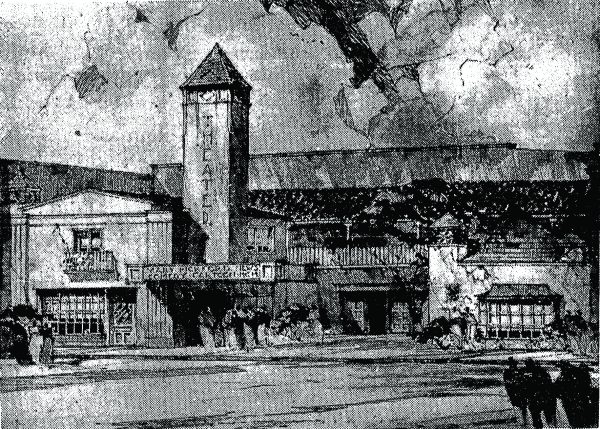

By Hunter Fuentes and Jon Stordahl
One of us (I’ll give you a hint: the older one) was confirmed at St. Vibiana’s, the former Cathedral of Los Angeles. That venerable structure was erected in the 1890s and served as the center of the city’s Catholic community for over a century. Damaged in the 1994 Northridge earthquake, the old church became a flashpoint for preservation efforts. After an extensive negotiation, an agreement was reached that led to the construction of a new cathedral on a different site and the repurposing of the old church. The large St. Vibiana’s complex was resurrected as a branch of the Los Angeles Public Library, an event space, and the restaurant Red Bird. Repurposing can mean salvation for our historic architecture.
Laguna is full of repurposed structures. One example of a successful reinvention of historic architecture is the Lumberyard restaurant. The current incarnation is not the first hospitality business to occupy the space. Some of us can remember Cedar Creek or even the Ivy, but this stunning building began life as a working lumberyard. It’s hard to imagine the Laguna Beach Lumber Company owner, Joe Jahraus, commissioning Jean Louis Egasse, one of the most creative and eccentric architects in Southern California, to design such a beautiful, whimsical structure for so utilitarian a purpose. But, Jahraus had served in Company C, 33rd Engineers in France during the First World War. His time abroad had left an impression that influenced the selection of Egasse and the elegant final design. Today, the space that once hummed with the rhythms of industry is filled with the laughter of diners and the sounds of live music.

Another favorite is 298 Broadway. This solid building has an attractive entry that mimics the Mission Style, with heavy wooden doors set into an almost adobe-looking façade. It was built in 1941 as a new post office. Between 1930 and 1940, the city’s population had more than doubled from 1,981 to 4,460 residents. The Los Angeles architectural firm of John and Thomas Cooper designed the new post office to better serve the growing town and as a complement to other Laguna civic buildings. Unfortunately, the location’s traffic and parking challenges proved too problematic and by 1953, it had been converted into a bank and later a Dean Witter brokerage. In the late 70s and early 80s, it housed the Jewish Community Center. It eventually became home to the private art collection of Gerald E. Buck, hidden within the four walls, inaccessible to the general public. Today, it houses the Honarkar Foundation, which has once again opened the doors to the community. We were able to visit the recent Jorg Dubin exhibition. It was wonderful to see this long-hidden gem once again filled with people.
The latest example of repurposed architecture is the newly restored South Coast Theater, now the Rivian showroom. That structure was designed by James N. Conway of Westwood and built by Smith Construction for Fred Aufdenkamp in 1936 as the New Lynn Theater. For the first half of its active life, the space had a single screen in a large auditorium. Around 1982, a sound wall was installed and two separate theaters were created. As audience expectations evolved and digital technology required expensive upgrades, it became financially unfeasible to continue operations as a conventional movie venue. The South Coast Theater closed in 2015. After a few years of slow decay, Rivian stepped forward with a proposal to completely restore the most historically relevant architectural details of the interior space and the exterior façade. The result is a vibrant hub of activity and a glowing presence in the heart of the downtown. It is a win for Rivian, a win for Laguna, and a win for preservation.
The late English director Peter Brook once claimed, “I can take any empty space and call it a bare stage.” What’s sadder than a vacant building? What’s more satisfying than bringing that deserted edifice back to life? Repurposing is not a new idea; they’ve been doing it for a long time. My favorite place in Rome is the Basilica of St. Mary and the Martyrs, but most people call it by its original ancient name, the Pantheon. Every bare stage deserves that second act.
Hunter Fuentes is a local resident and realtor with Compass in Laguna Beach, specializing in historic architecture. Jon Stordahl has lived in Laguna for over 20 years and is a retired history teacher. You can reach Hunter and Jon at [email protected] and [email protected].





The most commonly used term is “adaptive reuse,” and you are right, it’s key to preserving historic buildings.
Los Angeles is building 16,150 affordable housing units to satisfy a State housing mandate, Laguna requires 400 units under the same mandate. Those requirements are very consistent in proportion to resident populations. In 2022 Los Angeles the obstacles to affordable development were addressed by an Executive Directive executed by LA Mayor Karen Bass, ED-1 shortened the approval process from a year to 60-days. The LA ED-1 streamlines affordable housing defined as five or more units at 80% Area Medium Income or HUD, there is a 20/80 percent provision for mixed housing also. The LA directive targets elegible neighborhoods that can meet the AMI/HUD specification. In 2017 Laguna’s commercial vacancy rate was 7% where the county was 2.5%. Laguna could address affordable housing by Executive Directive also, targeting those vacant businesses with a proposal for adaptive reuse as mixed AMI/HUD housing.